Mexico’s “Grand Canyon” doesn’t have the scale of tourist-guide publicity that North America’s Grand Canyon does, but it’s every bit as impressive. Copper Canyon is a geological and environmental wonder that’s filled with life. Let’s discover Mexico’s Grand Canyon: Copper Canyon, including how deep and wide it is, what lives there, and exactly where you can find it.
What Is Mexico’s Copper Canyon?
The Barrancas del Cobre (that’s Spanish for ‘Copper Canyon’) is a group of six epic canyons in the Sierra Madre Occidental of Chihuahua in northwest Mexico. The canyon system formed 20 to 40 million years ago.
The six immense canyons were each formed by a river that carved a path through the volcanic mountains. They drain the Sierra Tarahumara’s western side and flow into the Rio Fuerte, finally draining into the Gulf of California. Together, these colossal canyons form the Copper Canyon region, so named for its coppery green colored walls.
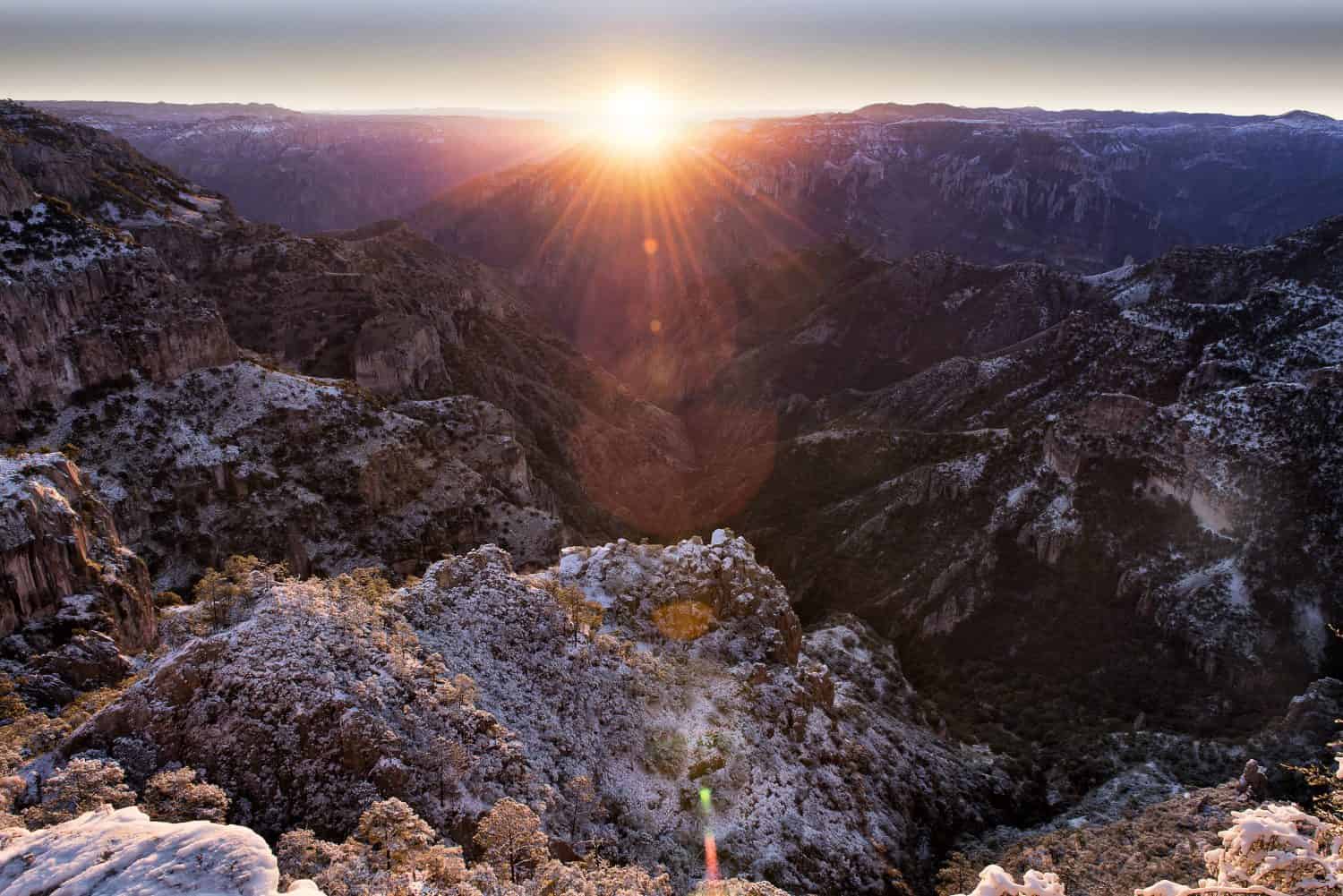
Copper Canyon is formed from six canyons, including the 6,135-foot-deep Urique Canyon.
©Fernando Gutierrez Ortega/Shutterstock.com
How Big Is Copper Canyon in Mexico?
Mexico’s Copper Canyon covers 25,000 square miles (65,000 square kilometers), and its deepest canyon reaches over 6,000 feet (1,828 meters) deep in places.
Its majestic sheer cliffs, drop-off, and craggy outcrops are frankly astonishing. Its high to low points create an epic array of ecosystems. At the highest points, winter brings snow, but in the deepest canyon, the winter climate is tropical.
The deepest canyons are:
- Urique: 6,135 feet (1,870 meters). It’s the deepest canyon in Mexico.
- Sinforosa: 6,000 feet (1,830 meters). Known as the Queen of Canyons.
- Batopilas: 5,900 feet (1,800 meters) A large native Tarahumara community lives here.
- Candameña: 5,380 feet (1,640 meters) Home to the two tallest waterfalls in Mexico.
Copper Canyon vs. Grand Canyon
Is Mexico’s Copper Canyon bigger than North America’s Grand Canyon? Yes.
Copper Canyon’s six canyons’ combined length is four times that of the Grand Canyon’s. It also beats the Grand Canyon in overall size with 25,000 square miles to the Grand Canyon’s 1,902.
When it comes to depth, they’re pretty much equal. The Grand Canyon has places that plunge to 6,000 feet with an average of 5,280 feet, compared to Copper Canyon’s deepest 6,135-foot canyon.
The two canyons share steep drops off and sheer cliffs but very different ecosystems. Copper Canyon is greener and lusher, with more plant life, than the Grand Canyon’s desert-like spaces.
However, compared to the world’s deepest place, they’re both cracks in the pavement! The deepest canyon on Earth is the Mariana Trench. This colossal underwater canyon reaches 44 miles across and 36,000 feet deep. That’s actually around 6.7 miles deep. The Mariana Trench could swallow both the Copper and Grand Canyons and still have five miles of depth to spare.
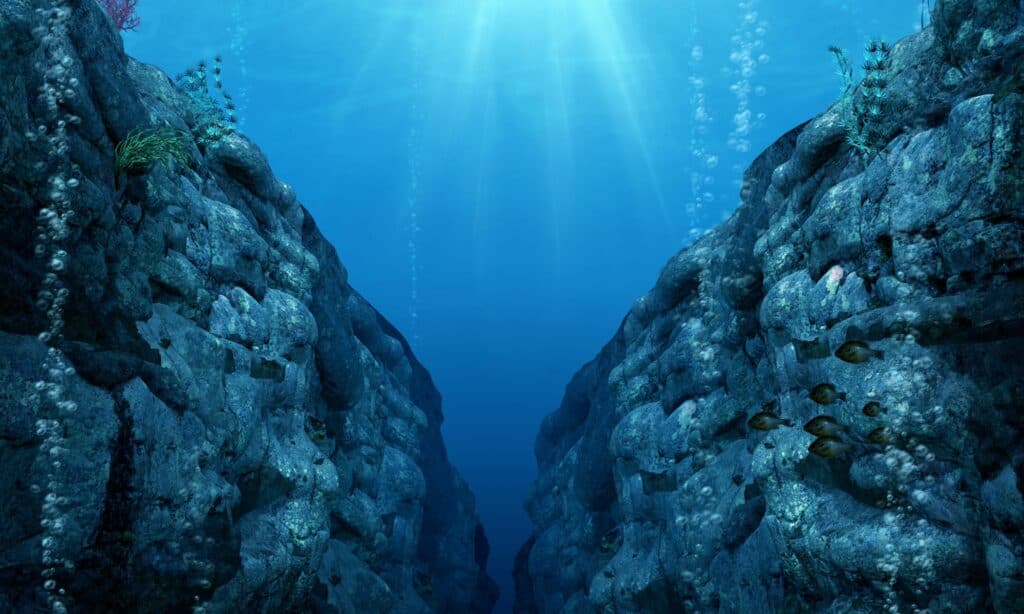
The Mariana Trench is 36,000 feet deep.
©iStock.com/ratpack223
Do People Live in Copper Canyon?
Yes, Copper Canyon is home to 35,000-70,000 traditional Raramuri (also called Tatahumara). These folks live in the mountain areas over the summer and move into the cool canyons over the summer.
Ramamuri are incredible weavers and endurance runners, capable of running uphill for hours on end. Their traditional, isolated way of life is threatened by tourism, but some communities work with the local government to build tourist facilities like restaurants and roads. More on Copper Canyon tourism below!
What Can You Do There?
Most of Mexico’s Copper Canyon is inaccessible. Very few paved roads exist, but widening tourism makes it possible to explore Copper Canyon on horseback or hiking with a guide.
The best way to explore Copper Canyon is onboard the Ferrocarril Chihuahua al Pacífico, the Chihuahua-Pacific Railway, or, colloquially, the Chepe train.
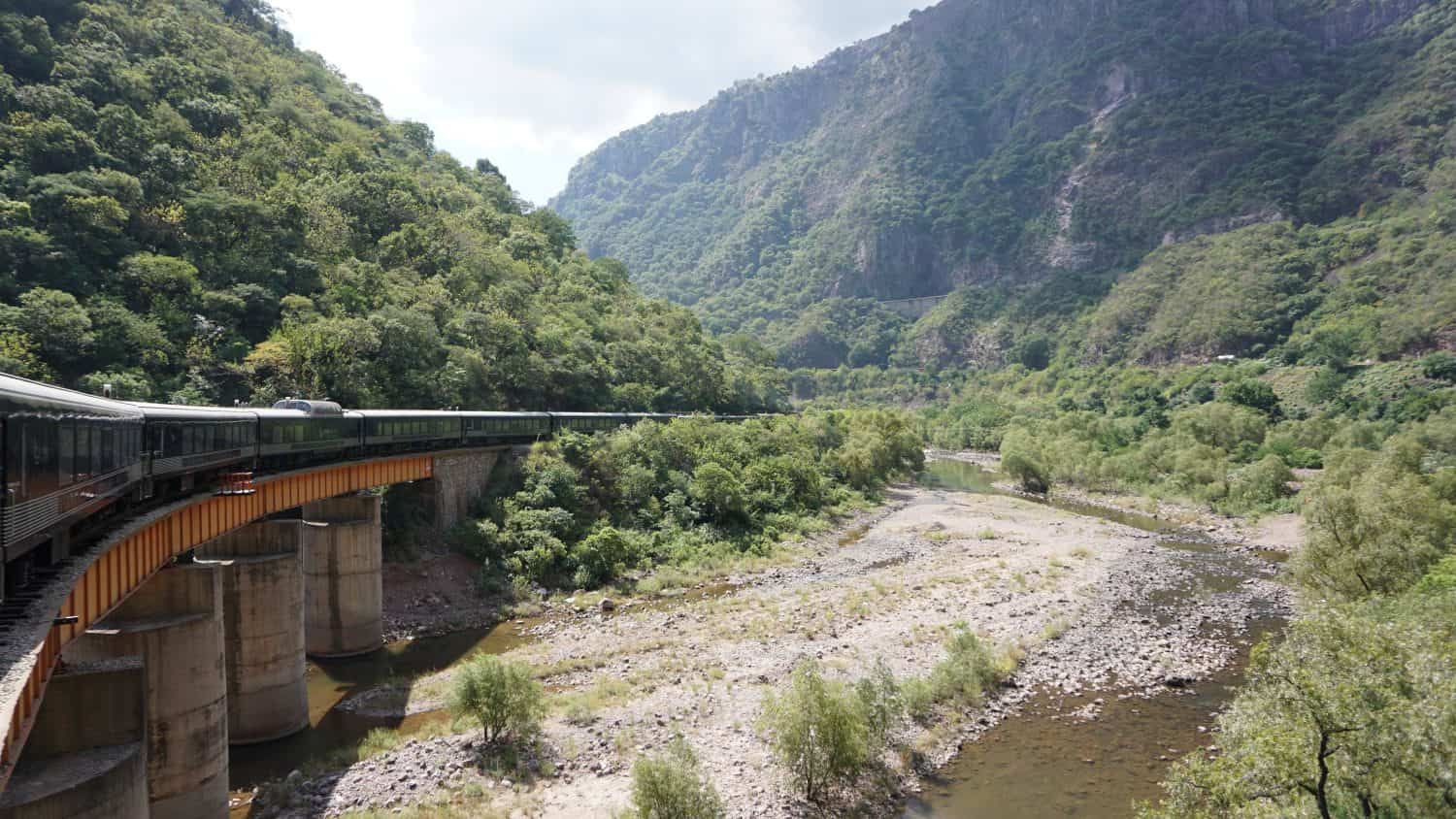
El Chepe train is the best way to view Mexico’s Copper Canyon.
©David Colin/Shutterstock.com
Chihuahua-Pacific Railway
Building started in the late 1800s, but events including the revolution, poor funding, and the sheer difficulties of building a safe railway along a canyon conspired to delay its completion until 1961. There are actually 39 bridges along its length and 86 tunnels, and one makes a 180-degree turn while descending 100 feet inside the canyon wall!
Today, the 405-mile Chihuahua-Pacific Railway takes 15 hours to run between Chihuahua and the Gulf of California’s Los Mochis. Cliff edges and 10 small towns host the tracks. Tourists can stop off at one of the towns for a few days to experience Mexican culture or ride the whole distance in one.
Copper Canyon National Park
On the Divisadero stop, about halfway along the railroad, is Parque Nacional Barranca del Cobre an adventure park with the second-longest zipline in the world. Its 8,300-foot-long Zip Rider soars 1,300 feet above ground between a canyon wall and a rocky outcrop. Riders reach a speedy 83 miles an hour!
Copper Canyon National Park is full of epic rock climbing spots, hanging bridges, mountain biking routes, and a few smaller, more sedate ziplines. There’s also a cable car and a glass-bottomed restaurant with an unusual descending view of Copper Canyon.
Breath-taking Waterfalls
Incredible Cascada Piedra Bolada and Basaseachic Falls nestle in Copper Canyon’s widest ravines. The spectacular waterfalls are just a few miles apart.
Cascada Piedra Bolada (round stone waterfall) is the tallest, with a 1,500-foot-long cascade that streams down rocky boulders into a rounded dip. It dries up from June to October, so it can’t claim the official title of the tallest waterfall in Mexico. That honor goes to the nearby Basaseachic waterfall.
Basaseachic waterfall tumbles 807 feet down a canyon wall all year round. Lots of hiking trails surround this natural beauty. It’s most spectacular just after the rainy season.
Take a tour from Creel town, which is on the Chepe train route, for the best experience.
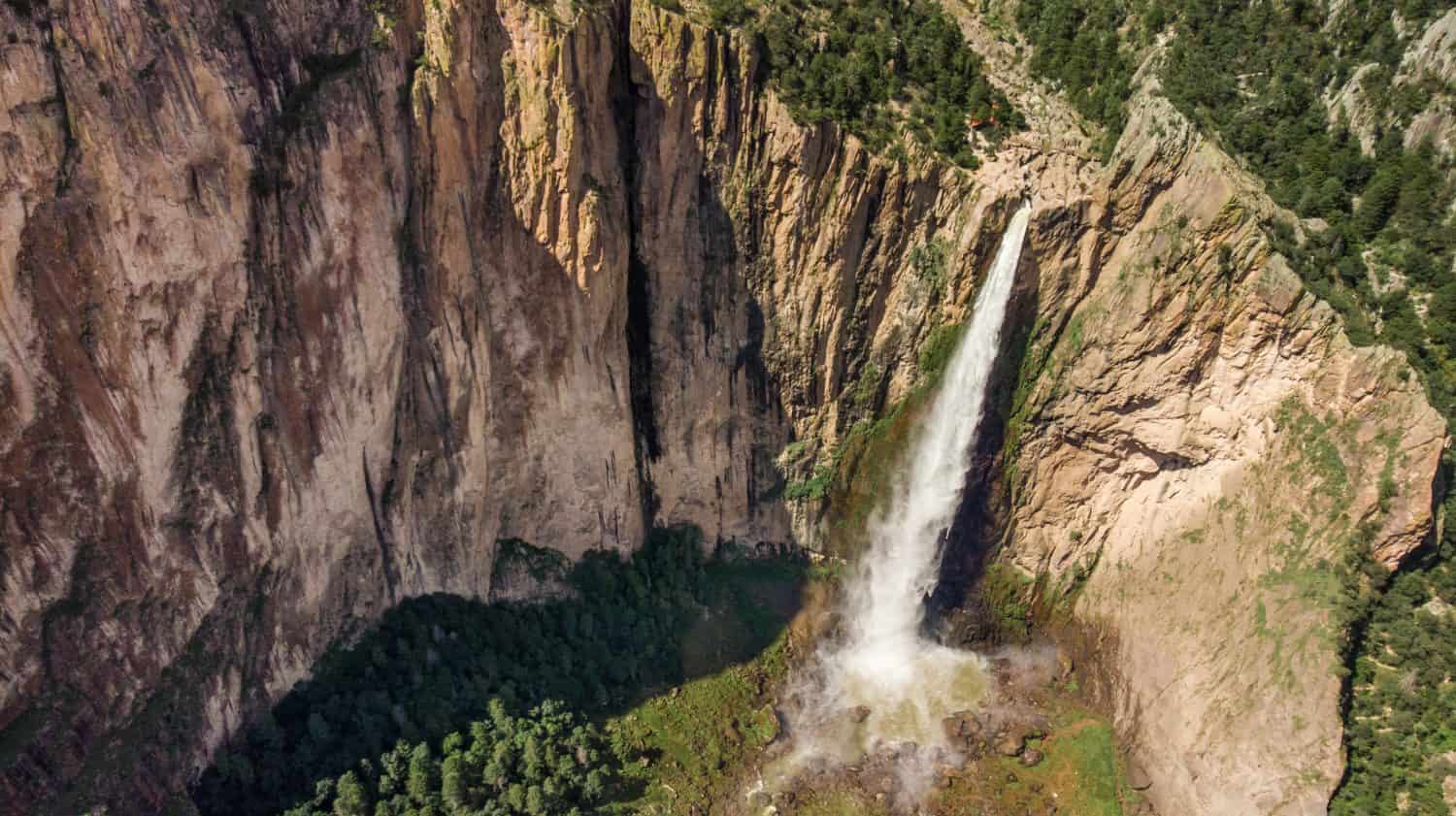
Basaseachic Waterfall is the tallest waterfall in Mexico.
©Andrea De la Parra/Shutterstock.com
Where Is It on a Map?
Copper Canyon is located in Chihuahua, Mexico, in the middle of the Sierra Madre Mountains.
Plants in Copper Canyon
Copper Canyon’s plummeting depths and steep gorges create incredible and varied ecosystems. Through the canyons, pine and oak trees dominate, especially the Mexican Douglas fir that grows at over 8,000 feet of altitude.
In fall, Andean alder, poplar, and brushwood blaze with color, and in the deep, warmer gorges, colossal fig trees, large cacti, and elegant palm trees enjoy the tropical humidity. In the deepest canyon, Urique Canyon, mid-winter temperatures hover at a balmy 25 degrees (75 F).
Just after the rainy season, wildflowers stud the landscape. The most common include:
- Lemmon’s sage
- Spider lily
- Trumpetbush
- Mexican asters
- Sonoran beardtongue
- Mexican bush marigold
However, many areas of deforestation threaten this incredible landscape. Supporters push to have this area declared a UNESCO World Heritage site due to its abundant flora, fauna, epic geology, and traditional tribe settlements.

After the rainy season, spider lilies bloom in Copper Canyon.
©pianoman555/Shutterstock.com
Animals in Mexico’s Copper Canyon
Birds
Over 300 bird species live between the canyon’s floor and rim, including the Mexican chickadee, a small songbird native to Mexico. These black-capped birds have white cheeks and a mixture of gray plumage with a long black bib. Insects and seeds are their chief diet, but relatively little is known about this handsome bird.
Other birds in Copper Canyon include eagles, rufus-crowned sparrows, parrots, and numerous hummingbirds.
Reptiles
In the warm areas of Copper Canyon lurk venomous Mexican bearded lizards. These reptiles grow 22 to 36 inches long, which is larger than their Gila Monster cousins. Semi-arboreal Mexican bearded lizards raid bird and reptile nests, and they hunt insects, small mammals, and amphibians, incapacitating them with venomous saliva. Other Copper Canyon reptiles include Mexican pine snakes, rattlesnakes, and scorpions.
Mammals
Cougars prowl Copper Canyon, preying on mammals, reptiles, and birds. This ferocious feline is also called the mountain lion, panther, catamount, or, in Copper Canyon, the puma.
Pumas can leap 20 vertical feet and 50 feet across gorges and rivers. It’s a perfectly designed predator for Copper Canyon’s wide range of heights.
Other mammals here include black bears, wild boar, squirrels, foxes, white-tailed deer, otters, and the Mexican wolf.
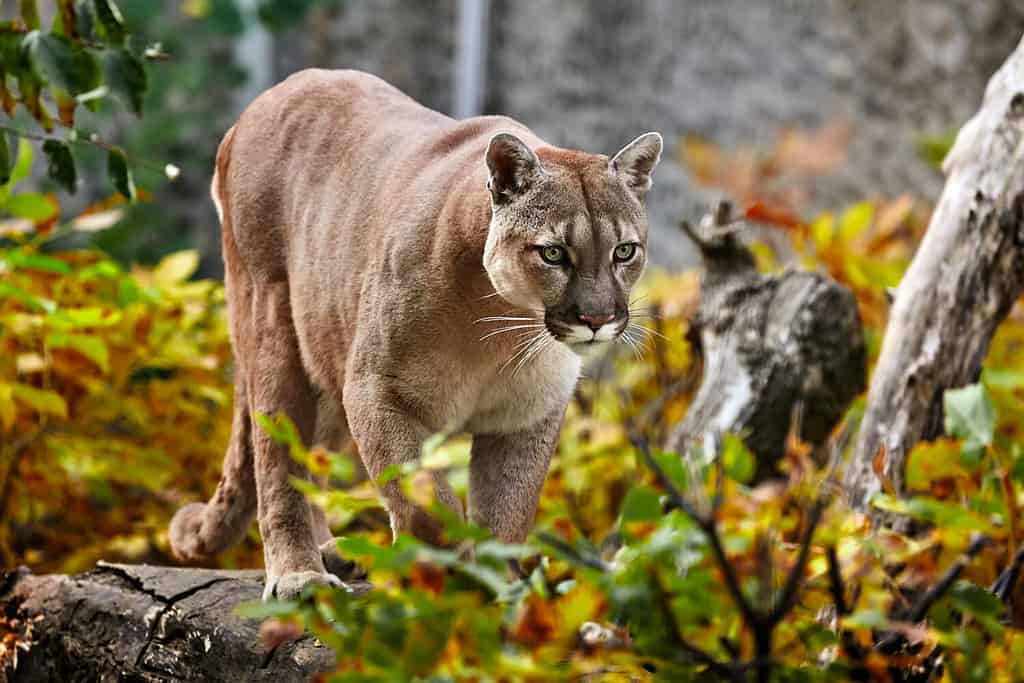
Pumas prowl Copper Canyon, preying on mammals, birds, and reptiles.
©Evgeniyqw/Shutterstock.com
The photo featured at the top of this post is © Fernando Gutierrez Ortega/Shutterstock.com
Thank you for reading! Have some feedback for us? Contact the AZ Animals editorial team.






